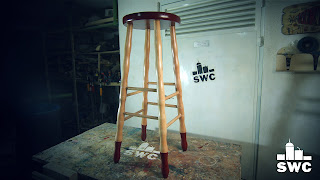Tools and materials I propose:
In this video I restore a bar stool I found in the garbage. The stool is made out of solid beech wood and MDF. It was an interesting project and I learned a lot of stuff in the process.
I begun by stripping the wood out of the old paint jobs. I used my heat gun and a spatula. This worked but it was a bit slow. So I used some paint stripper gel to remove the paint really fast. But be careful when using this stuff because it is really toxic.
I also used the heat gun to melt the glue in all the joints in order to break the whole thing apart.
To clean the paint I also used my random orbit sander, chisels and my rotary tool at really slow speed and a sanding bit.
The stool’s top had a big hole. I filled the hole by shaping a spruce dowel to size using my table saw.
I filled all small cracks with super glue and wood dust.
I gave the top a round over using my spoke shave and sand paper.
I glued the stool back together in stages. First I glued the two pairs of it’s legs, Then I glued the legs together and finally I glued the legs on the top. This made things much easier.
Finally I masked the legs and painted them and the top deep red with latex paint. I applied two coats in total. The heat gun helped me speed up the drying process.
Finally I finished the piece with two coats of clear, water based, satin varnish.
My stool came out great and I learned a ton of stuff trying to restore it. But that was it, see you soon with a new project video.
Disclosure: Some of the links below are affiliate links, meaning, that at no cost to you, I get a small commission if you click through and make a purchase.






























